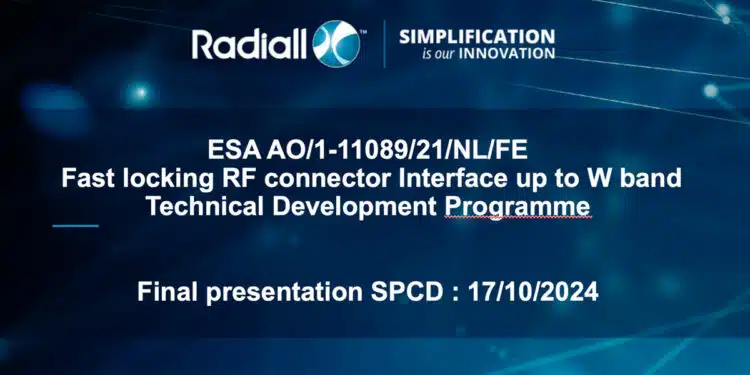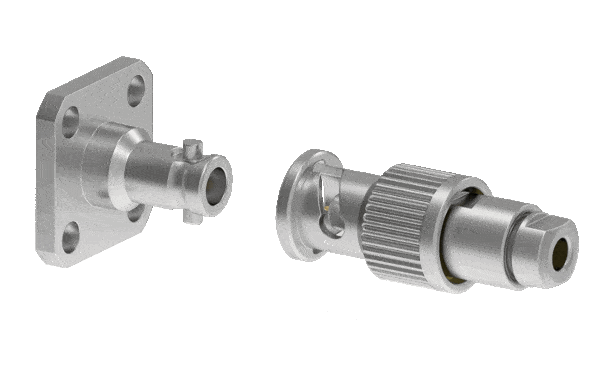This paper on new fast lock RF interface was presented by Olivier Berenfeld, Radiall SA, France during the 5th Space Passive Component Days (SPCD), an International Symposium held from October 15th to 18th, 2024, at ESA/ESTEC in Noordwijk, the Netherlands. Published under permission from ESA SPCD organizers.
RADIALL and AXON collaborated to develop a new fast-lock RF connector interface for satellite RF systems up to 110 GHz.
The project, funded by ESA, aimed to achieve TRL 4 and involved five work packages, including requirements analysis, design trade-offs, manufacturing, testing, and evaluation.
While the fast-lock system demonstrated robustness and reliability, the high cost and limited market demand prompted a reevaluation of the project’s direction, with a focus on qualifying a 110 GHz solution with a standard 1.0 mm interface for space applications.
Key Points:
- Market Analysis: No existing space applications for 110 GHz cable assemblies were found, with most available products designed for test and measurement.
- Fast-lock System Selection: Push and twist (“bayonet”) mechanism chosen for its simplicity, safety, and visibility, with an anti-rotation system to prevent cable twist.
- RF Line Optimization: Simulations optimized the 1.0 mm RF line, including socket shape, pin-socket gap, and center contact captivation method, to achieve best RF performance.
- Interface Development: Development and manufacturing of the new RF interface with a fast-locking mechanism, featuring a spring system for pressure between reference planes and manual mating/unmating.
- Connector Development: Developed truncated flange and 4-hole flange connectors with various contact outputs and adapters.
- Performance Evaluation: Evaluated connector pairs based on ESCC standards, identifying minor anomalies and comparing RF performances of fast-lock and screw-in versions.
- Project Conclusion: Fast-lock system is robust, reliable, and easy to use with good RF performance up to 110 GHz, but expensive with no immediate market.
- Technology Maturity: Coaxial technology at 110 GHz is concrete and promising, currently at TRL7.
- Next Steps: Qualify a 110 GHz solution with a standard 1.0 mm interface (screw-in) for space applications (TRL8).
- Market Considerations: Standardization and reliability are crucial for the Test and Measurement market, favoring screw-in interfaces over fast-lock.
Extensive Summary of the Development of a New Fast-Lock RF Connector Interface up to W-Band
The collaboration between RADIALL and AXON, funded by the European Space Agency (ESA), focused on developing a new fast-lock RF connector interface designed to operate effectively up to the W-Band (110 GHz). This development addresses future satellite manufacturer demands for higher frequency applications, following trends from X, Ku, Ka, and Q bands.
Project Structure (Work Packages)
- WP1: Space Applications Review & Requirements Benchmark
- Reviewed existing 110 GHz cable assemblies. Found no current space applications.
- Identified a lack of fast-lock systems with 1.0 mm connectors.
- Finalized specifications based on ESA tender requirements.
- WP2: RF Interconnection Design Review & Trade-off
- Evaluated three fast-lock mechanisms:
- Push-Lock (1 step): Simple but complex mechanisms and higher locking forces.
- Push & Lock (2 step): Compact with heritage in space but not optimized for very high frequencies.
- Push & Twist (Bayonet system): Chosen solution due to locking simplicity, safety, and clear visual confirmation of lock status.
- Anti-rotation systems were implemented to avoid cable twisting.
- Conducted extensive RF simulations to optimize performance.
- Evaluated three fast-lock mechanisms:
- WP3: Development & Manufacturing
- Developed new RF interfaces with fast-lock mechanisms, including:
- Spring systems for effective pressure without cable damage.
- Various flanges and connectors to compare fast-lock with traditional screw-in systems.
- Manufactured sample cable assemblies for evaluation.
- Developed new RF interfaces with fast-lock mechanisms, including:
- WP4: Characterization Tests & Optimization
- Performed tests based on ESCC standards.
- Minor anomalies identified with connector pairs, targeted for resolution in industrialization.
- Fast-lock connectors showed good insertion loss and VSWR but lower RF shielding effectiveness compared to screw-in versions, with performance degradation after repeated bending.
- WP5: Limitations, Improvements, & Payload Impact
- Conclusions:
- Fast-lock system is robust, reliable, and easy to use.
- Achieved good RF performance up to 110 GHz, except for RF leakage.
- High development costs with no immediate market demand for space applications.
- The traditional screw-in version remains preferable for Test & Measurement markets due to better performance stability and cost-effectiveness.
- Conclusions:
Final Remarks & Roadmap
- To reach Technology Readiness Level (TRL) 8:
- Address RF leakage issues through design improvements.
- Conduct industrialization and supplier analysis for mass production.
- Consider whether maintaining two interface types is cost-effective.
- Next Steps:
- More relevant to qualify a 110 GHz solution with a standard 1.0 mm screw-in interface for space applications.
Read the full paper:
































